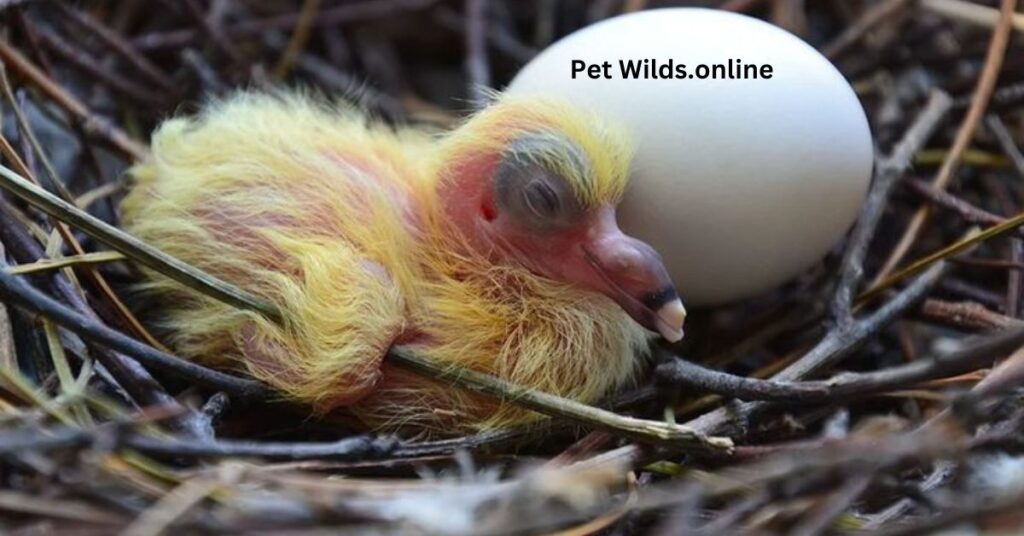Introduction:
Ever wondered why you never see baby pigeons? They’re actually out there, just well-hidden! In this guide, we’ll break down everything you need to know about baby pigeons—what they eat, how to take care of them, when they start flying, and more.

Why Don’t We See Baby Pigeons?
Baby pigeons, called squabs, stay in their nests until they’re almost fully grown. Pigeons build their nests in hidden spots like attics, ledges, and under bridges. By the time squabs leave the nest, they already look a lot like adult pigeons, which is why they seem to be “invisible.”
What Do Baby Pigeons Look Like?
Newborn pigeons are covered in yellowish down feathers with big beaks and oversized eyes. As they grow, they develop adult feathers and start looking more like the pigeons we recognize. If you’re curious, you can find plenty of baby pigeon pictures online!
What Do Baby Pigeons Eat?
Baby pigeons have a special diet, especially if they’re being hand-fed. Here’s what they eat:
- Pigeon Milk – Parent pigeons produce a thick, nutrient-rich substance called pigeon milk, which they feed to their babies by regurgitation.
- Hand-Feeding Formula – If you’re raising a baby pigeon, you can use a special baby bird formula or make a homemade mix from grains and water. A wide-neck pigeon nursing bottle or syringe works best for feeding.
- Feeding Schedule – Newborn pigeons need to eat every 2-3 hours. As they grow, they eat less frequently.
How to Feed a Baby Pigeon
If you’re hand-feeding a baby pigeon, follow these steps:
- Prepare the Formula – Use a commercial bird formula or a homemade grain mix.
- Use the Right Tools – A syringe or pigeon nursing bottle works best.
- Feed Gently – Let the pigeon eat at its own pace; never force-feed.
- Keep Things Clean – Always clean feeding tools after use to prevent infections.
How to Take Care of a Baby Pigeon
Taking care of a baby pigeon requires attention to a few key things:
- Keep Them Warm – Baby pigeons can’t regulate their body temperature, so use a heat pad or lamp to keep them cozy.
- Create a Safe Nest – Use a soft cloth or paper towels in a well-insulated box.
- Handle with Care – Be gentle when picking them up to avoid injuries.
- Maintain Hygiene – Keep their space clean to prevent infections.
How Do Pigeons Feed Their Babies?
Both pigeon parents take turns feeding their babies pigeon milk through regurgitation. As squabs grow, they start eating solid food on their own.
When Do Baby Pigeons Start to Fly?
Baby pigeons start flying at around 4 to 6 weeks old. By this time, they have developed strong feathers and enough energy to take their first flights.
How to Tell the Age of a Baby Pigeon
You can estimate a baby pigeon’s age by looking at:
- Feather Growth – Younger pigeons have sparse down feathers, while older ones are fully feathered.
- Size and Activity – Older pigeons are more active and attempt to fly.
Can Baby Pigeons Survive Without Their Mother?
Newborn pigeons can’t survive more than 24 hours without food. Older squabs may last a little longer, but they still need regular feeding and care.
What to Feed a Baby Pigeon in Urban Areas
If you find a baby pigeon in a city like NYC, you can buy special pigeon food from pet stores. If that’s not available, a homemade grain and water mix can work as an alternative.
Do Pigeons Really Produce Milk for Their Babies?
Yes! Pigeon milk isn’t like cow’s milk—it’s a protein-rich substance made in the parents’ crop that helps baby pigeons grow strong.
Can You Buy Baby Pigeons?
Baby pigeons aren’t commonly sold, but some breeders do offer them. If you plan to get one, be sure you’re ready for the responsibility of proper care.
Common Questions About Baby Pigeon Care
- How do pigeons feed their babies? Through regurgitation of pigeon milk.
- When do baby pigeons start flying? Around 4 to 6 weeks old.
- How long can baby pigeons survive without their mother? Only a few hours to a day without food.
Conclusion
Taking care of a baby pigeon involves proper feeding, warmth, and hygiene. Whether you found a lost squab or are just curious, this guide gives you all the basics to understand these fascinating birds!


